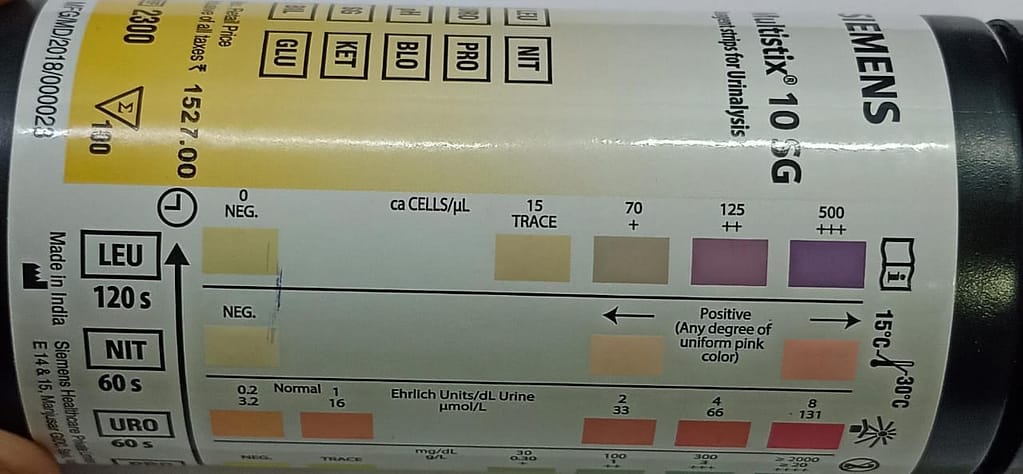Urine leukocyte esterase also known as WBC esterase is a component of urine analysis indicating presence of leukocytes in urine . Presence of leukocytes in urine is a sign of Urinary tract infection or inflammation. Neutrophils (pus cells) are the most common type of leukocyte present in UTI
Significance of leukocyte esterase
As neutrophils and other leukocytes are prone to lysis in urine (especially in hypotonic urine) ,leucocyte esterase activity can be indicative of remnants of cells that are not visible on microsopic examination of urine sediment.
positive leukocyte esterase results correlate with significant numbers of neutrophils, either intact or lysed. About 10 neutrophils per microlitre are considered significant and may indicate a urinary tract infection (UTI).
What is Leukocyte Esterase ?
Leukocyte esterase is an extract of primary azurophilic granules of human neutrophils which contains about 10 proteins with esterolytic activity. This esterolytic activity help to identify Leucocytes in urine
Test principle
Neutrophilic esterase catalyses the hydrolysis of esters to produce their respective alcohols and acids
The reagent pad in a Multistix strip contains an ester called 3-hydroxy-5-phenyl-pyyrole-N-tosyl-L-alanine. When leukocyte esterase is present in the urine, it breaks down this ester to form pyrole alcohol. Pyrole alcohol then reacts with a diazonium salt to form a purple color.
The multistix reagent pad contains 3 -hydroxy -5-phenyl-pyyrole-N-tosyl-L- alanine as ester ,which in the presence of leukocyte esterase form pyrole alcohol. the alcohol then reacts with diazonium salt to produce purple color.
The intensity of color produced is proportional to amount of enzyme present that correlates with number of neutrophils present in urine.

Test procedure
- Sample Collection and Storage: A clean, midstream urine sample is essential for accurate testing. Patients should be instructed on proper collection techniques to avoid contamination. The sample can be stored at room temperature for up to 2 hours. If delay is expected, the sample should be refrigerated and transported to the laboratory as soon as possible.
- Reagent Strips: Leucocyte esterase testing is typically done using reagent strips (dipsticks) specifically designed for urinalysis. These strips contain chemicals that react with leucocyte esterase in the urine.
- Dipstick Method: Dip the reagent strip into the urine sample according to the manufacturer’s instructions. Ensure that the strip is evenly wetted and allow it to react for the specified time.
- Reading Results: After the designated reaction time, compare the color change on the strip to the provided color chart. The intensity of the color change correlates with the level of leucocyte esterase in the urine.
- Interpretation: Results are usually categorized as negative, trace, +1, +2, or +3, with negative indicating no presence of leukocyte esterase and +3 indicating a high level of enzyme activity. The test is not designed to measure number of leukocytes.
clinical implications
positive results are clinically significant and may indicate
- Urinary tract infection
- Acute pyelonephritis
- Bladder tumour
- SLE
- Tuberculosis
Urinary sample positive with nitrite and leukocyte esterase should be sent for bacterial culture
Limitations of leukocyte esterase test
False positive results are seen in
- contamination with vaginal fluid discharge
- Trichomonas infection
- oxidizing agents and formalin may give false positive color
- Drugs like ampicillin ,kanamycin
False negative results are seen in
- Elevated specific gravity
- large amount of glucose and protein in urine
- Boric acid in urine
- Antibiotics like tetracycline, cephalexin
- Large amounts of ascorbic acid
Reference
Fischbach’s manual of Laboratory and diagnostics test
Henry’s clinical diagnosis and management by laboratory methods 23rd edition
Pfaller MA, Koontz FP. Laboratory evaluation of leukocyte esterase and nitrite tests for the detection of bacteriuria. J Clin Microbiol. 1985 May;21(5):840-2. doi: 10.1128/jcm.21.5.840-842.1985. PMID: 3998118; PMCID: PMC271794.


2 thoughts on “Urine leukocyte esterase test”